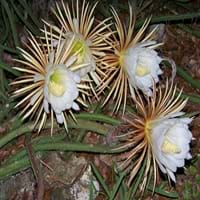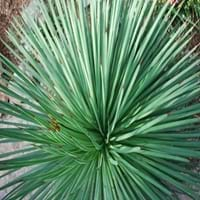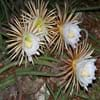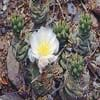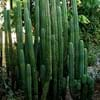Life Span
Annual and Perennial
Perennial
Type
Cactus or Succulent
Cactus or Succulent, Perennial
Origin
Mexico, Caribbean, Central America, South America
Southwestern United States, Mexico
Types
Not avilable
Not Available
Habitat
Desert
Desert, Dry areas, Semi desert
USDA Hardiness Zone
Not Available
12-15
AHS Heat Zone
Not Available
12-10
Sunset Zone
Not Available
10, 11, 12, 13, 14, 15, 16, 17, 18, 19, 20, 21, 22, 23, 24
Habit
Weeping
Rosette/Stemless
Minimum Width
Not Available
Flower Color
Dark Salmon, Sandy Brown, White, Yellow
Yellow
Flower Color Modifier
Multi-Color
Not Available
Fruit Color
Green
Non Fruiting Plant
Leaf Color in Spring
Not Available
Green, Blue Green
Leaf Color in Summer
Not Available
Green, Blue Green
Leaf Color in Fall
Not Available
Green, Blue Green
Leaf Color in Winter
Not Available
Green, Blue Green
Leaf Shape
Succulent
Long Linear
Plant Season
Not Available
Spring, Summer, Fall, Winter
Sunlight
Full Sun, Partial shade
Full Sun
Type of Soil
Sand
Loam, Sand
The pH of Soil
Alkaline, Neutral, Not Available
Neutral, Alkaline
Soil Drainage
Well drained
Well drained
Bloom Time
Early Spring, Early Summer, Late Spring, Late Winter, Mid Spring
Spring
Repeat Bloomer
Not Available
No
Tolerances
Drought
Drought
Where to Plant?
Container, Ground, Pot
Container, Ground, Pot
How to Plant?
Grafting, Seedlings
Leaf Cutting, Stem Planting, Transplanting
Plant Maintenance
Medium
Medium
Watering Requirements
Average Water Needs
Average Water Needs
In Summer
Lots of watering
Lots of watering
In Spring
Moderate
Moderate
In Winter
Average Water
Average Water
Soil pH
Not Available
Neutral, Alkaline
Soil Type
Not Available
Loam, Sand
Soil Drainage Capacity
Not Available
Well drained
Sun Exposure
Not Available
Full Sun
Pruning
Not Available
Remove damaged leaves, Remove dead branches, Remove dead leaves
Fertilizers
All-Purpose Liquid Fertilizer
No fertilizers needed
Pests and Diseases
Not Available
Insects, Red blotch
Plant Tolerance
Drought
Drought
Flower Petal Number
Semi-Double
Single
Fragrant Leaf
Not Available
No
Fragrant Bark/Stem
No
Not Available
Foliage Texture
Bold
Bold
Foliage Sheen
Not Available
Matte
Attracts
Not Available
Not Available
Allergy
Itchiness
Skin rash
Aesthetic Uses
Hanging Basket, Showy Purposes
Beautification, Landscape Designing, Showy Purposes
Beauty Benefits
Not Available
Not Available
Environmental Uses
Not Available
Air purification
Medicinal Uses
Not Available
Nutrients
Part of Plant Used
Fruits, Nut
Leaves
Other Uses
Used As Food, Used as Ornamental plant, Used for Landscaping
Decoration Purposes, Showy Purposes, Used As Food
Used As Indoor Plant
Yes
Yes
Used As Outdoor Plant
Yes
Yes
Garden Design
Container, Houseplant, Lawns and Turf, Mixed Border, Not Available, Tropical
Container, Dried Flower, Everlasting, Feature Plant, Rock Garden, Wall, Wildflower
Botanical Name
Selenicereus pteranthus
DASYLIRION
Common Name
Selenicereus, Moonlight cactus
Spoon flower, Common sotol
In Hindi
moonlight cactus
डेजर्ट चम्मच
In German
Selenicereus
Esslöffel
In French
Selenicereus
Desert cuillère
In Spanish
Selenicereus
Desierto cuchara
In Greek
Selenicereus
Desert κουτάλι
In Portuguese
Selenicereus
colher Desert
In Polish
Selenicereus
Desert łyżka
In Latin
moonlight cactus
cochleari deserto
Phylum
Tracheophyta
Magnoliophyta
Class
Magnoliopsida
Liliopsida
Order
Caryophyllales
Asparagales
Family
Cactaceae
Agavaceae
Genus
Selenicereus
Dasylirion
Clade
Angiosperms, Core eudicots, Eudicots
Angiosperms, Monocots
Tribe
Hylocereeae
Not Available
Subfamily
Cactoideae
Nolinoideae
Number of Species
Not Available
Not Available
Properties of Moonlight cactus and Desert Spoon
Wondering what are the properties of Moonlight cactus and Desert Spoon? We provide you with everything About Moonlight cactus and Desert Spoon. Moonlight cactus has thorns and Desert Spoon doesn't have thorns. Also Moonlight cactus does not have fragrant flowers. Moonlight cactus has allergic reactions like Itchiness and Desert Spoon has allergic reactions like Itchiness. Compare all the properties and characteristics of these two plants. Find out which of these plant can be used as indoor plant. If you are interested to decorate your house and garden, find out aesthetic uses, compare them and select the plant which will beautify your surrounding. Along with beautification, try comparing medicinal and edible uses of Moonlight cactus and Desert Spoon and you can choose the plant having best and most benefits.
Season and Care of Moonlight cactus and Desert Spoon
Season and care of Moonlight cactus and Desert Spoon is important to know. While considering everything about Moonlight cactus and Desert Spoon Care, growing season is an essential factor. Moonlight cactus season is Not Available and Desert Spoon season is Not Available. The type of soil for Moonlight cactus is Sand and for Desert Spoon is Loam, Sand while the PH of soil for Moonlight cactus is Alkaline, Neutral, Not Available and for Desert Spoon is Neutral, Alkaline.
Moonlight cactus and Desert Spoon Physical Information
Moonlight cactus and Desert Spoon physical information is very important for comparison. Moonlight cactus height is 30.00 cm and width Not Available whereas Desert Spoon height is 270.00 cm and width 180.00 cm. The color specification of Moonlight cactus and Desert Spoon are as follows:
Moonlight cactus flower color: Dark Salmon, Sandy Brown, White and Yellow
Moonlight cactus leaf color: Not Available
Desert Spoon flower color: Yellow
- Desert Spoon leaf color: Green and Blue Green
Care of Moonlight cactus and Desert Spoon
Care of Moonlight cactus and Desert Spoon include pruning, fertilizers, watering etc. Moonlight cactus pruning is done Not Available and Desert Spoon pruning is done Remove damaged leaves, Remove dead branches and Remove dead leaves. In summer Moonlight cactus needs Lots of watering and in winter, it needs Average Water. Whereas, in summer Desert Spoon needs Lots of watering and in winter, it needs Average Water.
